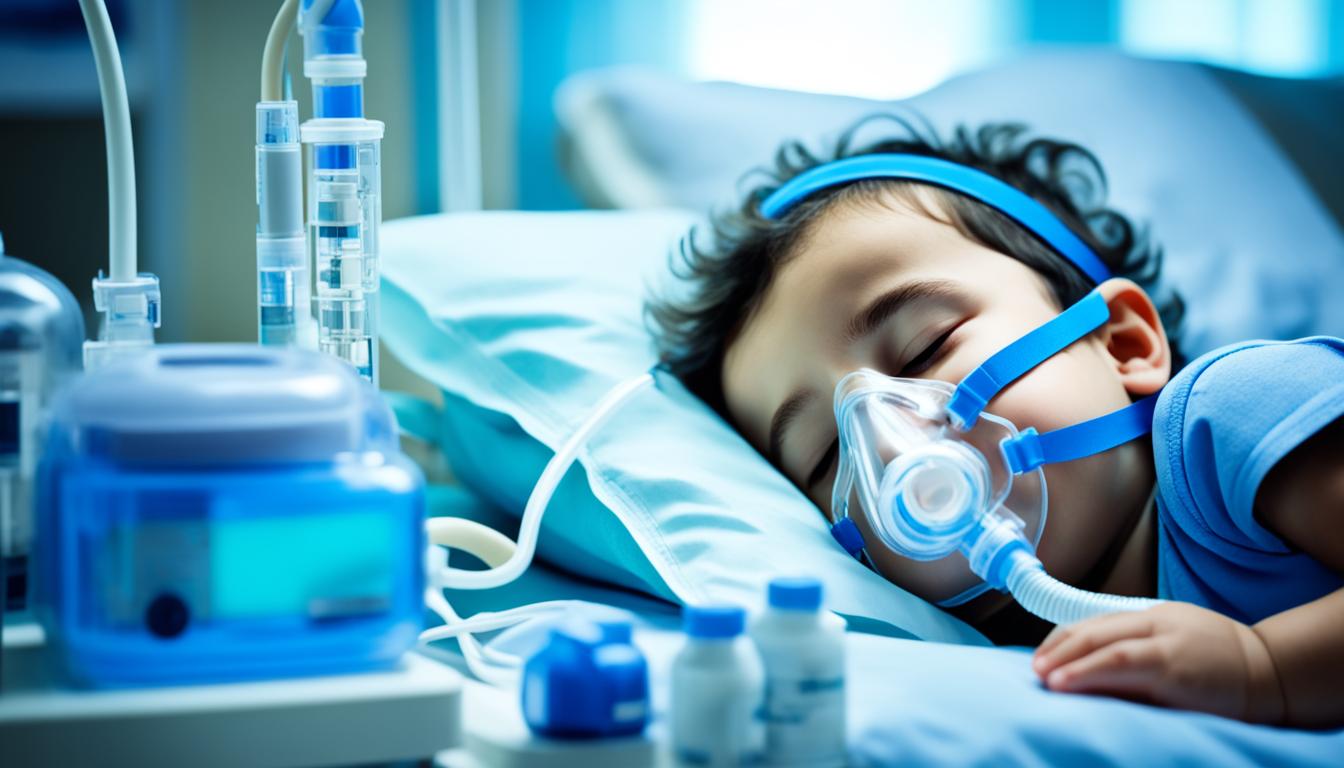Obstructive sleep apnea is a disorder in kids where they stop breathing for short times during sleep. It affects about 1 to 5 percent of children ages 2 to 8. These kids may snore loudly, have breathing pauses, and show other signs.
If not treated, sleep apnea can harm a child’s health and growth. It causes them to be tired all the time, struggle to learn, and act out. The condition can also delay their growth. The reasons for sleep apnea in children can be different for each child, from being overweight to having big tonsils or adenoids.
To find out if a child has sleep apnea, doctors usually do a sleep study. This study looks at how a child breathes, their oxygen levels, and heart rate while sleeping. Treatment can include things like losing weight, surgery, using a CPAP machine, or wearing special mouth guards when sleeping. Sometimes, doctors might even consider using stem cells.
Key Takeaways:
- Obstructive sleep apnea in children is a sleep disorder characterized by pauses in breathing during sleep.
- Main symptoms include loud snoring, pauses in breathing, mouth breathing, sleep terrors, and odd sleeping positions.
- If left untreated, pediatric sleep apnea can result in chronic daytime fatigue, learning problems, behavioral issues, and growth delays.
- Causes of sleep apnea in children can range from obesity to enlarged tonsils or adenoids.
- Diagnosis involves a sleep study, and treatment options may include lifestyle changes, surgery, CPAP therapy, oral appliances, or noninvasive positive pressure ventilation devices.
- Stem cell therapy is an innovative treatment option being explored for pediatric sleep apnea.
The Impact of Sleep Apnea on Children’s Health
Untreated sleep apnea in kids can really affect their health. It often causes chronic daytime tiredness and trouble focusing at school. Kids with this condition might not do as well in their studies. They can also be more hyperactive and have problems with their behavior.
This sleep issue can make it hard for children to do well socially. And they might also be slower in growing and learning. In bad cases, sleep apnea could hurt their heart health too. Moreover, it’s been linked to overpressure in adults, which can lead to heart problems. If not taken care of, it might even contribute to kids being overweight.
But, getting the problem spotted early on and treated can really help. This could mean a big improvement in a child’s life and health.
| Complications of Untreated Sleep Apnea in Children | Effects on Health |
|---|---|
| Chronic daytime fatigue | Sleep apnea can cause excessive daytime sleepiness, affecting a child’s energy levels and overall well-being. |
| Difficulty paying attention in school | Children with sleep apnea may struggle to concentrate, leading to academic difficulties and a negative impact on their educational performance. |
| Learning problems | Untreated sleep apnea can interfere with cognitive function, making it challenging for children to learn and retain information. |
| Poor academic performance | Sleep apnea-related issues can result in lower academic achievement and hinder overall educational progress. |
| Hyperactivity and behavioral issues | Sleep apnea can contribute to hyperactive behavior, impulsivity, poor focus, and other behavioral problems in children. |
| Growth and cognitive delays | Children with sleep apnea may experience delays in physical and cognitive development, impacting their overall growth and well-being. |
| Heart problems | Severe cases of sleep apnea can strain the heart and increase the risk of cardiovascular issues, including heart disease. |
| High blood pressure in adults | Untreated childhood sleep apnea has been linked to elevated blood pressure in adulthood, raising the risk of cardiovascular events. |
| Association with childhood obesity | Sleep apnea can contribute to weight gain and obesity in children, further exacerbating health-related concerns. |
Diagnosis and Treatment Options for Childhood Sleep Apnea
Diagnosing childhood sleep apnea starts with a detailed symptom check and a physical exam. A pediatric sleep study, known as polysomnography, is then often carried out. This test is noninvasive and checks brain waves, breathing, blood oxygen levels, and heart rate. It’s key for identifying sleep apnea’s severity and causes. It helps doctors plan treatment accurately.
The treatment for childhood sleep apnea depends on each child’s situation. Those with sleep apnea from being overweight might benefit most from losing weight and being more active first. If large tonsils or adenoids are the cause, the first step could be surgery to remove this tissue. Known as adenotonsillectomy, it can greatly improve sleep quality and symptoms.
Children with more severe cases or who don’t get better from surgery might need different treatments. These could include CPAP therapy, where the child wears a mask that connects to a machine. This machine keeps the airways open during sleep by blowing air. For some, oral devices or pressure ventilation devices can help. These are good options when surgery or CPAP isn’t the best choice.
Ongoing sleep medicine research is also looking into using stem cells to treat childhood sleep apnea. This method aims to repair and rebuild the airway’s damaged tissues. Although it’s still in the early stages, it’s an exciting direction for managing sleep apnea in kids.

